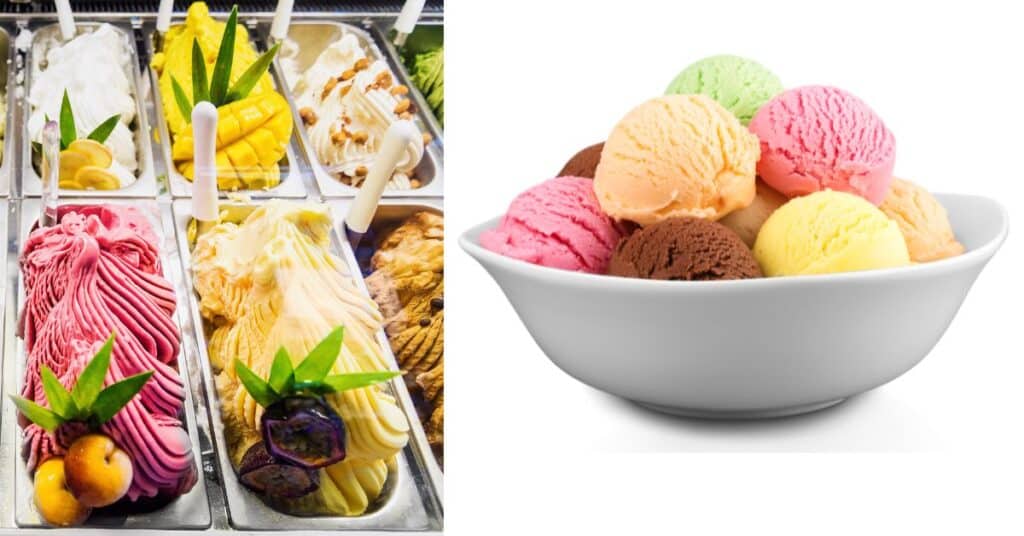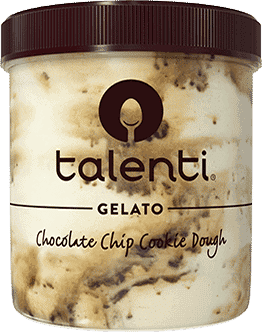
When exploring the world of frozen desserts, two popular choices stand out: ice cream and gelato. As much as they may seem similar, they have unique characteristics that set them apart. In this section, we’ll dive into their differences regarding ingredients, texture, and cultural origins.
Ingredients and Proportions
The main ingredients in both ice cream and gelato are milk, cream, sugar, and sometimes egg yolks. However, the proportions and fat content differ:
| Dessert | Milk | Cream | Sugar | Egg yolks | Fat content |
|---|---|---|---|---|---|
| Ice Cream | Moderate | High | High | Optional | 10-25% |
| Gelato | High | Moderate | Moderate | Common | 4-9% |
Ice cream uses more cream and sugar, resulting in a higher fat content. Gelato, on the other hand, has more milk and often includes egg yolks, leading to a lower fat content.
Texture and Temperature
One of the key differences between ice cream and gelato is their texture. Ice cream has a lighter, fluffier texture because it’s churned at faster speeds, which adds more air, known as overrun. Gelato has a denser, smoother texture as it’s churned at slower speeds, with less overrun. Gelato is also served at a slightly warmer temperature than ice cream.
Cultural Origins
The cultural origins also set ice cream and gelato apart. Ice cream is an American favorite, believed to have been introduced in the United States in the 18th century. Gelato, on the other hand, has Italian roots, with its origins traced back to the Renaissance period. When you visit an Italian gelateria, you’ll experience an extensive range of flavors crafted with care to showcase the best of Italian ingredients and culinary creativity.
The Science of Ice Cream vs. Gelato
Churning Process
The churning process plays a significant role in the difference between ice cream and gelato. Ice cream is churned at a high speed, which incorporates more air, giving it a lighter, fluffier texture. On the other hand, gelato is churned at a slower speed, resulting in less air and a denser product.
Density and Overrun
As a result of the different churning processes, ice cream and gelato vary in density and overrun. Overrun refers to the percentage of air in the final product:
| Ice Cream | Gelato | |
|---|---|---|
| Overrun | 50-100% | 20-35% |
| Density | Light and airy | Dense and thick |
Since gelato has a lower overrun, it’s denser than ice cream. Additionally, gelato contains less butterfat (4-9%) compared to ice cream (14-25%), which contributes to its creamier mouthfeel and rich flavor.
Flavor and Consistency
Here’s how ice cream and gelato differ in flavor and consistency.

- Ice cream: Most ice creams are high in fat, resulting in a smooth and creamy mouthfeel. However, the high butterfat content can sometimes mask the flavorings, making them less pronounced.

- Gelato: The dense, velvety consistency of gelato is due to its reduced air content and smaller ice crystals.
Nutritional Comparison
Caloric Content
When looking at the caloric content of gelato and ice cream, it’s important to keep in mind the serving size. While both desserts are based on similar ingredients, they differ in the ratio of ingredients used.
Gelato:
- Typically has fewer calories per serving compared to ice cream
- A 3.5-ounce (100-gram) scoop of gelato contains about 160 calories
Ice Cream:
- Tends to pack in more calories per serving
- A 3.5-ounce (100-gram) scoop of ice cream has around 207 calories
These numbers can vary based on the flavor and brand of your chosen treat, but it’s safe to say that gelato is generally lower in calories than ice cream.
Fat Ratios
Considering fat content, there’s a noticeable difference between gelato and ice cream, mainly due to the butterfat content.
Gelato:
- Contains less milk fat than ice cream
- Around 4% to 9% milk fat
- Less cream and a higher ratio of whole milk
Ice Cream:
- Must have at least 10% milk fat, but can go up to 25% in some cases
- Larger amount of heavy cream
The lower fat content in gelato allows for a more intense flavor profile, as fat coats your taste buds and can often mute flavors. As a result, gelato may be considered a healthier option compared to ice cream when looking at fat content. Additionally, considering the sugar levels, they are mostly similar in both gelato and ice cream. However, this can vary depending on the brand or the flavor chosen. So, it’s essential to keep an eye on the sugar content as well when choosing between the two desserts.
Serving and Enjoyment
Serving Style and Temperature
When it comes to serving style and temperature, gelato and ice cream offer different experiences. Traditionally, gelato is served at a slightly warmer temperature than ice cream, resulting in a softer, silkier texture. Visit a gelateria to get the authentic experience of watching your gelato expertly scooped and presented in a beautiful display.
On the other hand, ice cream is typically served at a colder temperature, giving it a firmer consistency. When you go to an ice cream shop, you’ll notice that the ice cream is often scooped with a round scooper or served in a cylindrical roll with a spatula.
Flavor Variety and Pairings
While both gelato and ice cream come in numerous flavors, there are some differences in the available options and how they are paired together. Here’s a short comparison table for your reference:
| Gelato | Ice Cream |
|---|---|
| Focus on natural flavors | Wide range of creative flavors |
| Nutty flavors (pistachio, hazelnut) | Classic base flavors (chocolate, vanilla, strawberry) |
| Fruit flavors (fresh and seasonal) | Mix-ins (candy, cookies, and more) |
| Complementary flavors for a coherent experience (coffee, stracciatella) | Customizable options in some ice cream shops (hot fudge, toppings) |
Gelato flavors tend to focus on natural and high-quality ingredients. You might find classic Italian flavors like pistachio and stracciatella or seasonal fruit flavors depending on the time of year.
Ice cream, however, is more versatile when it comes to flavor experimentation. From classic favorites like vanilla and chocolate to newer inventions and mix-in options, the choices are seemingly limitless.
Frequently Asked Questions

What are the key differences in ingredients between gelato and ice cream?
The main differences in ingredients between gelato and ice cream are the milk-to-cream ratio and the presence of egg yolks. Gelato typically contains more milk and less cream compared to ice cream. Additionally, gelato often includes egg yolks, while ice cream recipes may or may not include them.
How does the sugar content in gelato compare to that of ice cream?
The sugar content in gelato and ice cream can be quite similar, but it varies depending on the recipe. Some gelato flavors may have slightly more sugar, while others may have less.
Is there a difference in fat content between gelato and ice cream?
Yes, gelato generally has a lower fat content than ice cream because it has a higher milk-to-cream ratio. Ice cream typically contains a minimum of 10% milkfat, while gelato has a milkfat content of 3.25% to 8%.
Why does gelato often have a denser texture than ice cream?
Gelato has a denser texture mainly due to two factors: churning speed and air incorporation. Gelato is churned at a slower speed than ice cream, resulting in less air being incorporated into the mixture. This slower churning produces a denser, smoother, and creamier final product.
Can you find egg ingredients in gelato but not typically in ice cream?
Egg yolks are commonly found in gelato recipes, but they are not a requirement for making ice cream. Some ice cream recipes do include egg yolks, particularly for richer, custard-based versions. However, many ice creams are made without eggs, using just milk, cream, sugar, and flavorings.
